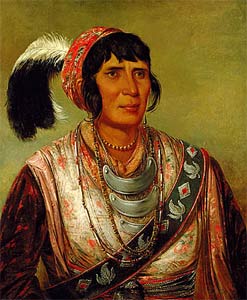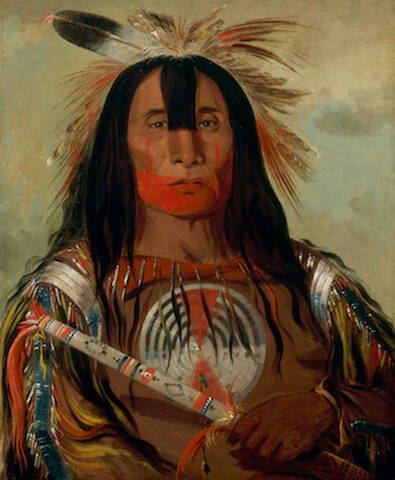George Catlin was born in 1796 in Wilkes-Barre, Pennsylvania.
As a child he had strong interests in the out-of-doors and
less in schooling. He studied and practiced law briefly, but
enjoyed art more. He quit his practice and travelled to
Philadelphia to take up the latter profession in 1823. He
became friends with a number of local artists, including
Rembrandt Peale. He became proficient enough at art to gain
membership standing in the Pennsylvania Academy of Fine Arts
by 1824.
With a letter of introduction to William Clark, he travelled
to St. Louis in 1830 and later that year and the next
accompanied Governor Clark to council meetings held on the
middle Missouri. This was the start of his portraits of
Indians and their environment. For the next six years his
typical experience was to spend the winters in or around St.
Louis making money by painting portraits of the local
inhabitants and the summers in Indian territory.
In 1836 he went to New York City and opened a show of his
works and artifacts he had collected. He latter opened shows
in London and Paris. All were enthusiastically received. Due
to financial miss-dealings, he entered a state of bankruptcy
in 1852. His paintings and materials were purchased by Joseph
Harrison, an American, who then shipped all goods home to
Philadelphia where they remained in storage until seven years
after the artist's death.
Catlin returned home and from 1852 to 1860 travelled widely,
both in North and South America. He repainted many of his
older paintings from sketches and memory. He died in 1872.
Following the death of Joseph Harrison in 1879, his heirs
offered the Catlin materials to the United States Government.
The materials were transferred to the Smithsonian Institution
and are now on view at various locations in Washington, DC.
The second set of paintings were purchased by the American
Museum of Natural History and the New York Historical Society.
Catlin's paintings capture for us an image of what Indian
society was like before the groups had been decimated by small
pox or internecine warfare.

"I have seen him shrinking from civilized approach, which
came with all its
vices, like the dead of night upon him. I have seen him gaze
and then
retreat like the frightened deer ... seen him shrinking from
the soil and
haunts of his boyhood, bursting the strongest ties which
bound him to the
earth and its pleasures. I have seen him set fire to his
wigwam and smooth
over the graves of his fathers ... clap his hand in silence
over his mouth,
and take the last look over his fair hunting ground, and
turn his face in
sadness to the setting sun. All this I have seen performed
in nature's
silent dignity ... and I have seen as often the approach of
the bustling,
busy, talking, whistling, hopping, elated and exulting white
man, with the
first dip of the ploughshare, making sacrilegeous trespass
on the bones of
the valiant dead .... I have seen the grand and irresistible
march of
civilization. I have seen this splendid juggernaut rolling
on and beheld its
sweeping desolation, and held converse with the happy
thousands, living
as yet beyond its influence, who have not been crushed, nor
yet have
dreamed of its approach."
"They waste us, aye, like April snow,
In the warm noon we shrink away;
And fast they follow as we go
Towards the setting day,
Till they shall fill the land, and we
Are driven into the Western sea. "
"Gleaming with the setting sun
One burning sheet of living gold,
The mountain Lake beneath him rolled;
In all her length far winding lay,
With promontory, creek, and bay,
And islands that, empurpled bright,
Floated amid the livelier lights
To sentinel enchanted land."

"Osceola"
Black Drink
Osceola's name was derived from the Indian term
"Asiyahola,"
the cry given by those taking the ceremonial black drink
that was supposed
to cleanse the body and spirit.
"This gallant fellow is grieving with a broken spirit, and
ready
to die, cursing the white man, no doubt to the end of his
breath."

Catlin,
self-portrait painting an Indian chief, c. 1841
Other Related Sites
SAAM:
George Catlin's Indian Gallery
Smithsonian
American Art Museum
617
works by Catlin
George
Catlin - Classroom Internet Library
National
Portrait Gallery

References:
Hassrick, Royal B. THE GEORGE CATLIN BOOK OF AMERICAN INDIANS
1977 Promontory Press brown cover with gilt ltg on spine.
Illustration throughout with the art of George Catlin.
Catlin, George: Unter den Indianern Nordamerikas. KMJB, 1918,
Nr. 1, S. 82-97.
Neumann, Heinz: Karl May und George Catlin: eine Hypothese.
M-KMG, Monat 12, 1970, Nr.6, S. 19.
Ostwald, Thomas: Die Entwicklung der Indianergeschichten bei
Karl May - 2. Abschnitt: Karl May und George Catlin.
Graff-Anzeiger, Monat 3, 1976, Nr. 9, S. 19-23. Enthlt hier
nur Reprint aus Catlin
Ostwald, Thomas: Die Entwicklung der Indianergeschichten bei
Karl May, dargestellt am
Beispiel der Wandlung Winnetous vom Gewaltmenschen
zumEdelmenschen Teil IV.
Graff-Anzeiger, Monat 12, 1975, Nr. 8, S. 28-33. Mit einem
Abschnitt "Karl May und George Catlin"
Poppe, Werner: Karl May und George Catlin. M-KMG, Monat 6,
1972, Nr. 12, S. 22.
Schneider, Alfred: George Catlin, Die Indianer Nordamerikas.
M-KMG, Monat 6, 1973, Nr. 16, S. 30.
Wolff, Gabriele: George Catlin: Die Indianer Nord-Amerikas.
Das Material zum Traum.

 Return to Indigenous Peoples' Literature
Return to Indigenous Peoples' Literature
Compiled by: Glenn
Welker
ghwelker@gmx.com
Copyright
@ 1993-2016
This site has been accessed 10,000,000 times since
February 8, 1996.








